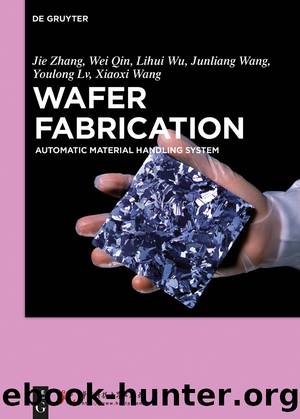Wafer Fabrication by Zhang Jie;

Author:Zhang, Jie; [Неизв.]
Language: eng
Format: epub
Publisher: De Gruyter
Published: 2018-09-06T20:00:00+00:00
5.3.1.2 Agent-Based Distributed Algorithm
Since the 1990s, with the development of computer networks and computer communications technology, agent technology has not only become a hotspot for distributed artificial intelligence research, but also become a hot field of information technology. It is noted that research achievements in various fields of artificial intelligence should be integrated into an agent of intelligent behavior. The nature of artificial intelligence is social intelligence. âCollaboration,â âcompetitionâ and ânegotiationâ are the main manifestations of human intelligent behavior. The prerequisite for the application of the agent is to achieve its intelligent behavior by building an agent, guiding its interaction with the surrounding environments and communicating with other agents, which play an important role in forming new computing and problem-solving norms and establishing an agent technology-based distributed collaborative model with certain autonomy.
In terms of the theoretical basis, the structure of an agent can be classified into three major classes: (1) Thinking agent (cognitive or deliberative agent): In this type, the information processing unit consists of a variety of behavioral knowledge, domain knowledge and decision rules. The information processing unit is able to implement complex logical reasoning in order to make decisions. (2) Reactive agent: In this type, the information processing unit does not include any domain knowledge and behavior knowledge of the environment. Complex reasoning mechanisms are not adopted by the information processing unit, and decision-making is performed by using the predefined rules inside the information processing unit. (3) Hybrid agent: It is a new structure that is formed by the combination of the above two structures.
The âperception-actionâ mappings are preset in the internal part of a reactive agent; when certain conditions are met by the environmental information, an agent directly calls the preset perception-action mappings to generate its corresponding action output. The basic structure of a reactive agent is shown in Figure 5.6. In the figure, information perception and actions are combined by the perception-action relationship base, which interacts with the environment through sensors and actuators.
Download
This site does not store any files on its server. We only index and link to content provided by other sites. Please contact the content providers to delete copyright contents if any and email us, we'll remove relevant links or contents immediately.
| Automotive | Engineering |
| Transportation |
Whiskies Galore by Ian Buxton(41528)
Introduction to Aircraft Design (Cambridge Aerospace Series) by John P. Fielding(32888)
Small Unmanned Fixed-wing Aircraft Design by Andrew J. Keane Andras Sobester James P. Scanlan & András Sóbester & James P. Scanlan(32573)
Craft Beer for the Homebrewer by Michael Agnew(17932)
Turbulence by E. J. Noyes(7700)
The Complete Stick Figure Physics Tutorials by Allen Sarah(7137)
Kaplan MCAT General Chemistry Review by Kaplan(6595)
The Thirst by Nesbo Jo(6435)
Bad Blood by John Carreyrou(6274)
Modelling of Convective Heat and Mass Transfer in Rotating Flows by Igor V. Shevchuk(6222)
Learning SQL by Alan Beaulieu(6035)
Weapons of Math Destruction by Cathy O'Neil(5827)
Man-made Catastrophes and Risk Information Concealment by Dmitry Chernov & Didier Sornette(5645)
Digital Minimalism by Cal Newport;(5389)
Life 3.0: Being Human in the Age of Artificial Intelligence by Tegmark Max(5184)
iGen by Jean M. Twenge(5161)
Secrets of Antigravity Propulsion: Tesla, UFOs, and Classified Aerospace Technology by Ph.D. Paul A. Laviolette(4987)
Design of Trajectory Optimization Approach for Space Maneuver Vehicle Skip Entry Problems by Runqi Chai & Al Savvaris & Antonios Tsourdos & Senchun Chai(4839)
Electronic Devices & Circuits by Jacob Millman & Christos C. Halkias(4746)
